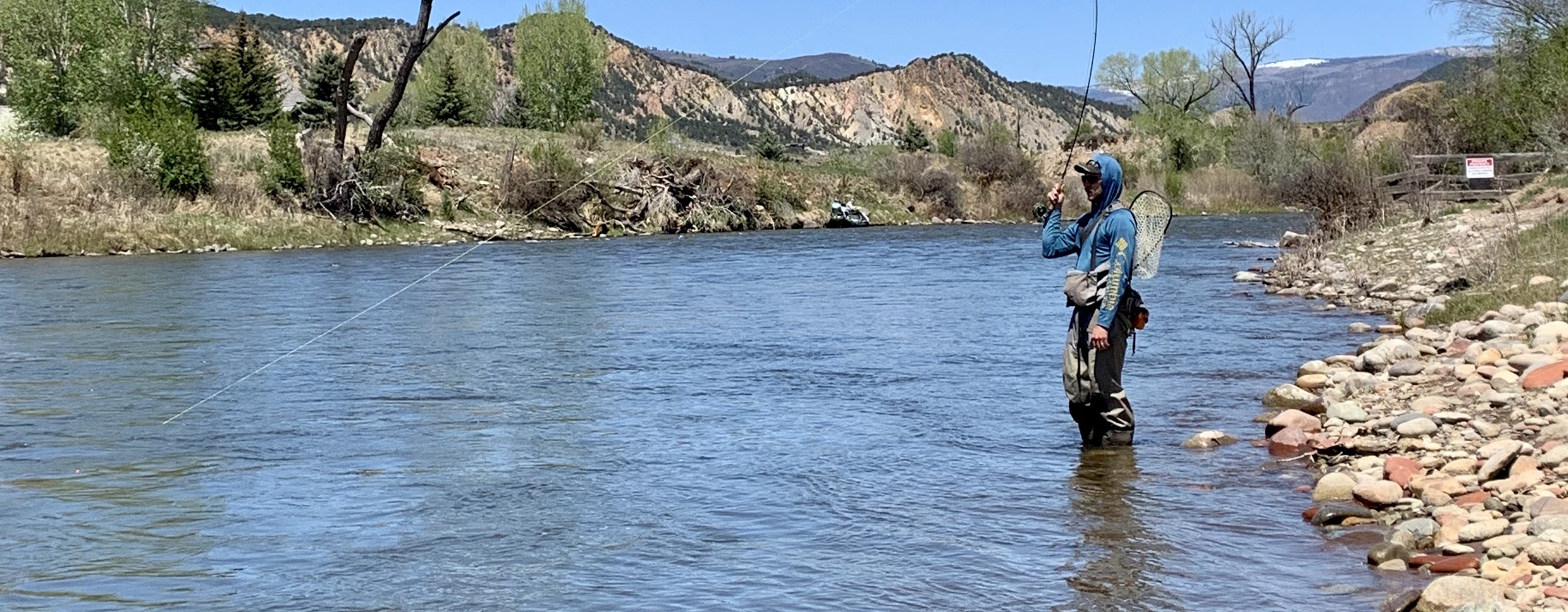
Weekly Report
Note: This will be the last report update that will be provided. We’ve loved every minute of this journey and value the relationships we’ve made and the community that we’ve built but unfortunately, it’s time for us to focus on other priorities. Roaring Fork flows gradually returned to the low 600 cfs range after hitting a high of 780 cfs last weekend. A mix of rain and snow in the forecast early next week could impact flows but the impact should be minimal and brief. It’s been a cool week in the Roaring Fork Valley and while the mornings have gotten off to a slower start, fishing during the late morning and afternoon has been great. Trout are eager to chase large meals and are feeding on a variety of bugs. Cloud cover over the next week will increase streamer productivity throughout the day, so don’t feel like you have to ditch your streamer for a nymph setup during the afternoon. When it comes to nymphing, flashy attractor/searcher patterns are highly productive. Red Copper Johns, red Squirmy Worms, Egg Sucking Leeches, eggs, Guide’s Choice Hare’s Ears, Psycho Prince Nymphs, Flashback Pheasant Tails and Rainbow Warriors are solid lead patterns for a nymph rig. Below one of those patterns, trail your confidence midge pupa or baetis emergers. Darth Baetis, Sparkle Wing RS2s, purple/red Zebras, Mercury Black Beauties and Jujubee Midges have been particularly productive. As we move deeper into fall, trout are starting to favor their winter lies throughout the day. Think deep pools, soft runs and pockets. Warm afternoon temps and hatches will pull opportunistic trout into slow riffles and faster seams but for the most part, you’re better off focusing on soft water. Trout are most active between 10 and 4 pm, so let the river sit during the early morning hours.
Recommended Flies
Sub-surface
- Bling Midge (#20-22)
- Black Beauty (#20-22)
- Zebra Midge (#20-22)
- Top Secret Midge (#20-22
- Mercury Midge (#20-22)
- WD 40 (#20-22)
- JuJu Baetis (#18-20)
- RS2 (#18-20)
- Chocolate Foam Back Emerger (#20-22)
- Barr's Emerger (#18-20)
- Darth Baetis (#18-20)
- Electric Caddis (#16-18)
- Caddis Candy (#16-18)
- Sparkle Pupa (#16-18)
- Pats Rubber Legs (#10-12)
- Mini-Leech
- San Juan Worm
- yarn egg
- Prince Nymph (#16-18)
- Mercury Pheasant Tail (#16-20)
- Guide's Choice Hare's Ear (#16-18)
- red Copper John (#16-18)
- Rainbow Warrior (#16-18)
- Frenchie (#16-18)
- Roza's Red Tag Jig (#18)
Surface
- Griffiths Gnat (#20-22)
- Parachute Adams (#20-22)
- Hi-Vis BWO (#18-20)
- Elk Hair Caddis (#16-18)
- All-Season Caddis (#16-18)
Streamers
- Mini Viking Midge
- Barely Legal
- Boogyman
- white Sparkle Minnow
- black Wooly Bugger
- Cheech Leech
Need flies for your trip? FlyCast has collaborated with our friends at Anglers All to package a dozen flies that are hot on the Colorado River Basin, right now - Click here for hand selected flies
River Flow
Detailed River Info
Background:
The Roaring Fork is a gold medal freestone river that originates in the Hunter-Fryingpan wilderness, just south of Aspen. The Roaring Fork flows north through the town of Aspen, Basalt, Carbondale and Glenwood springs where it meets the Colorado River. As it makes its way through the Roaring Fork Valley, the river increases in size from a small pocket water stream to a wide river. The upper section of the river near Aspen is home to cutthroats, brown trout and rainbow trout. Downstream, the river is populated with healthy rainbows, browns and whitefish.
Angling:
The Roaring Fork has something to offer every angler. Anglers looking for small stream fishing and easy access will gravitate towards the stretch between Aspen and Basalt. From Basalt to Glenwood Springs, the river offers great wade fishing year-round and float fishing from late spring through the fall. The most popular stretch for float fishing is Carbondale to Glenwood Springs, which is ideal because wading access is limited by private property. The Roaring Fork experiences a vast number of hatches throughout the year consisting of midges, BWOs, PMDs, green drakes, caddis, golden stoneflies, yellow sallys and terrestrials. While these trout are generally less selective like most freestone trout, high water clarity throughout most of the year can make fishing more technical. Nymphing and streamer fishing is the most consistent tactic but if you time it right, you’ll experience fantastic dry fly fishing during one of the many hatches.
River Access
Depending upon the stretch you wish to fish, accessibility varies. Between Carbondale and Glenwood Springs, access is limited due to a large amount of private property, but there are a number of SWA and public access points for anglers to utilize. Above Carbondale, anglers will find more access points. The Roaring Fork River parallels highway 82 from Glenwood Springs to Aspen. So, if you’re looking to explore the river, drive south along highway 82 towards Aspen and keep an eye out for pull-offs and marked access points. Refer to the map below for some of our favorite access points.